YAMAHA KODIAK 700 2018 Repair Manual
Manufacturer: YAMAHA, Model Year: 2018, Model line: KODIAK 700, Model: YAMAHA KODIAK 700 2018Pages: 172, PDF Size: 4.52 MB
Page 61 of 172

6-2
6
The rear brake lever or brake pedal is applied
with the drive select lever in any position. How-
ever, it is recommended to shift into the neutral
or park position before starting the engine.
3. Apply the rear brake lever or brake pedal.
4. Completely close the throttle lever and start
the engine by pushing the start switch.TIPIf the engine fails to start, release the start switch,
then push it again. Pause a few seconds before
the next attempt. Each cranking should be as
short as possible to preserve battery energy. Do
not crank the engine more than 10 seconds on
each attempt. NOTICEECB00164For maximum engine life, never accelerate
hard when the engine is cold!
EBU36230Operating the drive select lever and
driving in reverseNOTICEECB03330Do not shift without coming to a complete stop
and waiting for the engine to return to normal
idle speed. Damage to the engine or drivetrain
may occur. Shifting: Neutral to High-range and High-range
to Low-range1. Bring the ATV to a complete stop.
2. Apply the brake pedal, and then shift by mov- ing the drive select lever along the shift guide.TIPMake sure that the drive select lever is completely
shifted into position.
UB1662E0.book Page 2 Monday, April 17, 2017 11:39 AM
Page 62 of 172
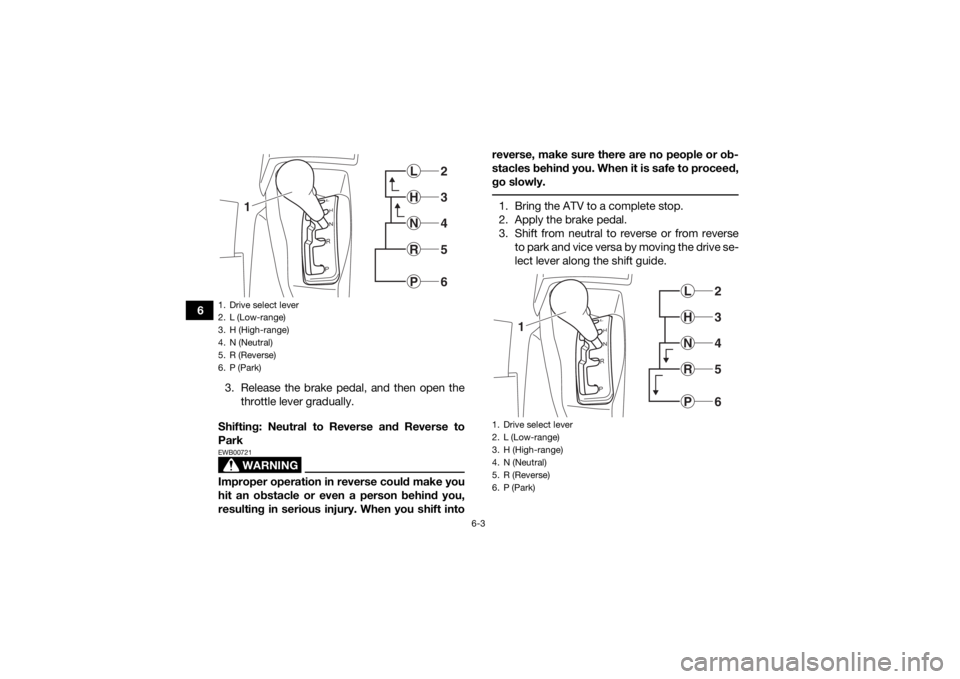
6-3
63. Release the brake pedal, and then open thethrottle lever gradually.
Shifting: Neutral to Reverse and Reverse to
Park
WARNING
EWB00721Improper operation in reverse could make you
hit an obstacle or even a person behind you,
resulting in serious injury. When you shift into reverse, make sure there are no people or ob-
stacles behind you. When it is safe to proceed,
go slowly.
1. Bring the ATV to a complete stop.
2. Apply the brake pedal.
3. Shift from neutral to reverse or from reverse
to park and vice versa by moving the drive se-
lect lever along the shift guide.
1. Drive select lever
2. L (Low-range)
3. H (High-range)
4. N (Neutral)
5. R (Reverse)
6. P (Park)
1
23456
LHNRP
1. Drive select lever
2. L (Low-range)
3. H (High-range)
4. N (Neutral)
5. R (Reverse)
6. P (Park)
1
23456
LHNRP
UB1662E0.book Page 3 Monday, April 17, 2017 11:39 AM
Page 63 of 172

6-4
6
TIPWhen in reverse, the reverse indicator light
should come on. If the indicator light does not
come on, have a Yamaha dealer check the elec-
trical circuit.
Due to the synchronizing mechanism in the en-
gine, the indicator light may not come on until
the ATV starts moving. 4. Check behind for people or obstacles, and
then release the brake pedal.
5. Open the throttle lever gradually and continue to watch to the rear while backing.EBU20684Engine break-inThere is never a more important period in the life
of your engine than the first 320 km (200 mi) or 20
hours of operation. For this reason, you should fol-
low the engine break-in instructions carefully.
Since the engine is brand new, do not put an ex-
cessive load on it for the first 320 km (200 mi) or
20 hours. During this period the various parts in
the engine wear and polish themselves to the cor-
rect operating clearances. Avoid prolonged full-
throttle operation or any condition that might re-
sult in engine overheating. 0–160 km (0–100 mi) or 0–10 hours
Avoid prolonged operation above 1/2 throttle.
Vary the speed of the ATV regularly. Do not oper-
ate it at one set throttle position.
160–320 km (100–200 mi) or 10–20 hours
Avoid prolonged operation above 3/4 throttle. Rev
the engine freely, but do not use full throttle at any
time.
320 km (200 mi) or 20 hours and beyond
The ATV can now be operated normally.
NOTICEECB00221If any engine trouble should occur during the
engine break-in period, immediately have a
Yamaha dealer check the ATV. EBU27322ParkingWhen parking the ATV, stop the engine, and shift
the drive select lever into the park position.
UB1662E0.book Page 4 Monday, April 17, 2017 11:39 AM
Page 64 of 172
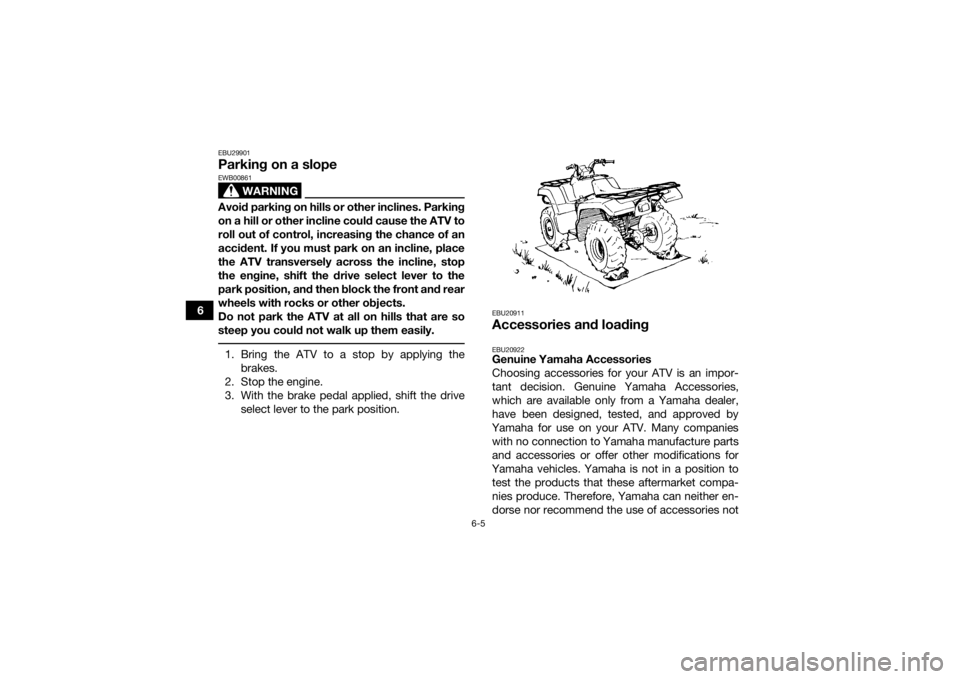
6-5
6
EBU29901Parking on a slope
WARNING
EWB00861Avoid parking on hills or other inclines. Parking
on a hill or other incline could cause the ATV to
roll out of control, increasing the chance of an
accident. If you must park on an incline, place
the ATV transversely across the incline, stop
the engine, shift the drive select lever to the
park position, and then block the front and rear
wheels with rocks or other objects.
Do not park the ATV at all on hills that are so
steep you could not walk up them easily. 1. Bring the ATV to a stop by applying thebrakes.
2. Stop the engine.
3. With the brake pedal applied, shift the drive select lever to the park position.
EBU20911Accessories and loadingEBU20922Genuine Yamaha Accessories
Choosing accessories for your ATV is an impor-
tant decision. Genuine Yamaha Accessories,
which are available only from a Yamaha dealer,
have been designed, tested, and approved by
Yamaha for use on your ATV. Many companies with no connection to Yamaha manufacture parts
and accessories or offer other modifications for
Yamaha vehicles. Yamaha is not in a position to test the products that these aftermarket compa-
nies produce. Therefore, Yamaha can neither en-
dorse nor recommend the use of accessories not
UB1662E0.book Page 5 Monday, April 17, 2017 11:39 AM
Page 65 of 172

6-6
6
sold by Yamaha or modifications not specifically
recommended by Yamaha, even if sold and in-
stalled by a Yamaha dealer.
Aftermarket parts, accessories, and modifica-
tions
While you may find aftermarket products similar in
design and quality to genuine Yamaha Accesso-
ries, recognize that some aftermarket accessories
or modifications are not suitable because of po-
tential safety hazards to you or others. Installing
aftermarket products or having other modifica-
tions performed to your ATV that change any of
the vehicle’s design or operation characteristics
can put you and others at greater risk of serious
injury or death. You are responsible for injuries re-
lated to changes in the vehicle.
Keep the following in mind when considering an
accessory or operating an ATV which has acces-
sories.
Accessories should be rigidly and securely
mounted. An accessory which can shift position
or come off while you are riding could affect
your ability to control the ATV.
Do not mount an accessory where it could inter-
fere with your ability to control the ATV. Exam-
ples include (but are not limited to) a heavy or bulky object attached to the handlebars which
could make steering difficult, an accessory that
limits your ability to move around on the seat, or
one that limits your view.
Use extra caution when riding an ATV with ac-
cessories. The ATV may handle differently than
it does without accessories.
EBU21042Loading
WARNING
EWB00821Never exceed the stated load capacity for this
ATV. Overloading this ATV or carrying or tow-
ing cargo improperly could cause changes in
ATV handling which could lead to an accident.
Cargo should be properly distributed and se-
curely attached. Reduce speed when carrying
cargo or pulling a trailer. Allow greater dis-
tance for braking. Cargo or a trailer can change the stability and han-
dling of an ATV.
You must use common sense and good judgment
when carrying cargo or towing a trailer. Keep the
following points in mind:
UB1662E0.book Page 6 Monday, April 17, 2017 11:39 AM
Page 66 of 172

6-7
6
Never exceed the weight limits shown. An over-
loaded ATV can be unstable.
Do not exceed the maximum tongue weight.
You can measure tongue weight with a bath-
room scale. Put the tongue of the loaded trailer
on the scale with the tongue at hitch height. Ad-
just the load in the trailer, if necessary, to reduce the weight on the hitch. If you are carrying cargo
and towing a trailer, include the tongue weight
in the maximum ATV load limit.
Load cargo on the carriers as close to the center
of the ATV as possible. Put cargo at the rear of
the front carrier, at the front of the rear carrier,
and center it.
Tie down cargo securely to the carriers. Make
sure cargo in the trailer cannot move around. A
shifting load can cause an accident.
Make sure the load does not interfere with con-
trols or your ability to see where you are going.
Ride more slowly than you would without a
load. The more weight you carry, the slower you
should go. Although conditions vary, it is good
practice not to exceed low range whenever you
are carrying heavier loads or when towing a
trailer.
Allow more braking distance. A heavier ATV
takes longer to stop.
Avoid making sharp turns unless at very slow
speeds.
Avoid hills and rough terrain. Choose terrain
carefully. Added weight affects the stability and
handling of the ATV.
MAXIMUM LOADING LIMIT
ATV loading limit (total weight of rider, car-
go, accessories, and tongue):240.0 kg (530 lb)
Front carrier: 50.0 kg (110 lb)
Rear carrier: 90.0 kg (198 lb)
Storage compartment: 4.0 kg (9 lb)
Trailer hitch: Pulling load (total weight of trailer and
cargo):5880 N (600 kgf, 1322 lbf)
Tongue weight (vertical weight on trailer
hitch point): 147 N (15 kgf, 33 lbf)
UB1662E0.book Page 7 Monday, April 17, 2017 11:39 AM
Page 67 of 172
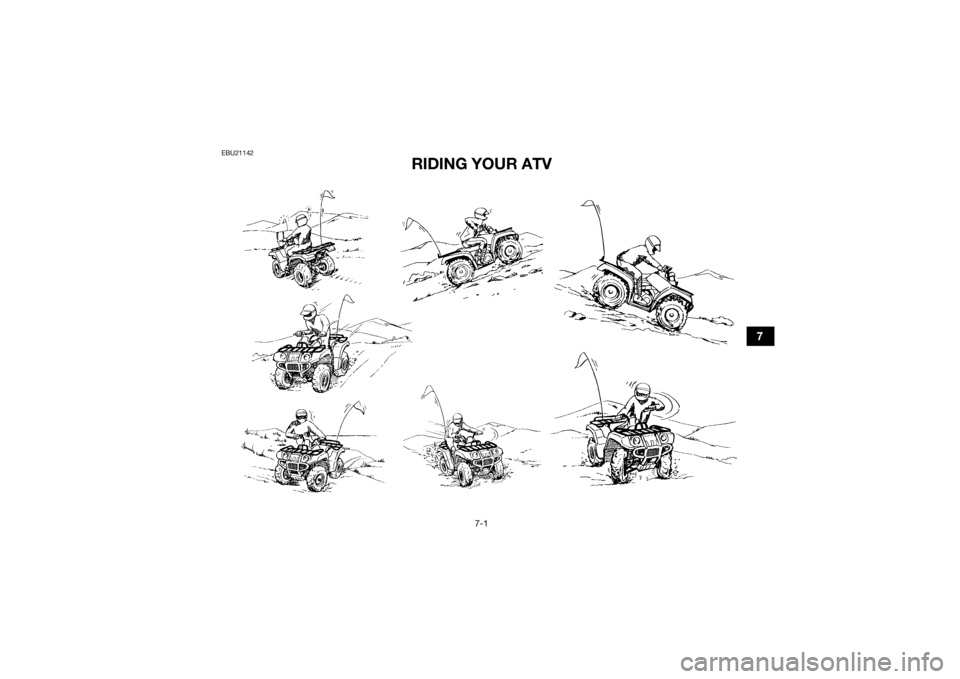
7-1
7
EBU21142
RIDING YOUR ATV
UB1662E0.book Page 1 Monday, April 17, 2017 11:39 AM
Page 68 of 172
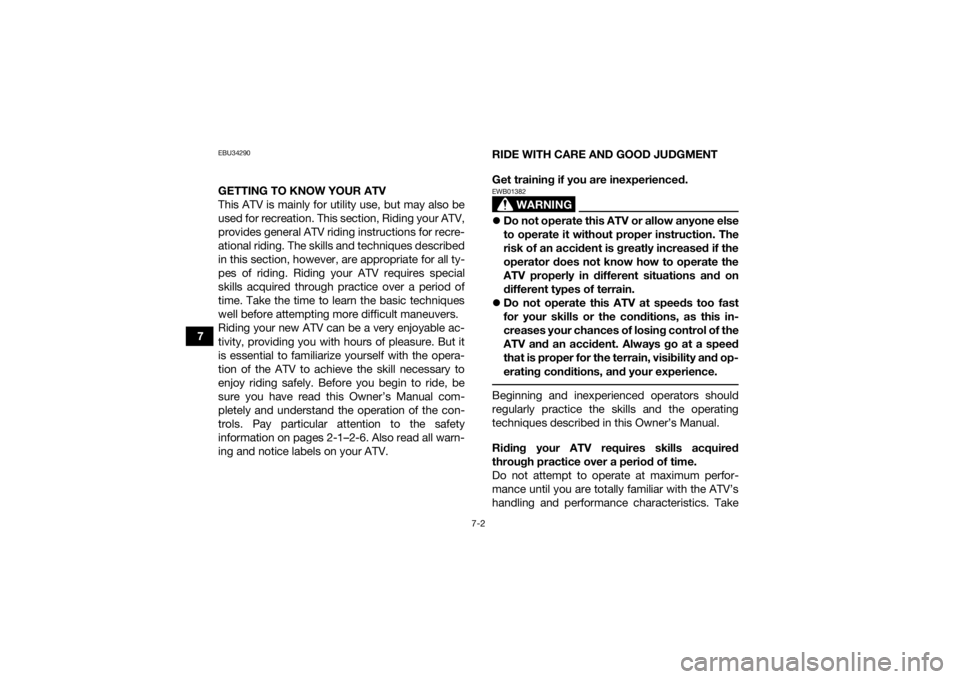
7-2
7
EBU34290GETTING TO KNOW YOUR ATV
This ATV is mainly for utility use, but may also be
used for recreation. This section, Riding your ATV,
provides general ATV riding instructions for recre-
ational riding. The skills and techniques described
in this section, however, are appropriate for all ty-
pes of riding. Riding your ATV requires special
skills acquired through practice over a period of
time. Take the time to learn the basic techniques
well before attempting more difficult maneuvers.
Riding your new ATV can be a very enjoyable ac-
tivity, providing you with hours of pleasure. But it
is essential to familiarize yourself with the opera-
tion of the ATV to achieve the skill necessary to
enjoy riding safely. Before you begin to ride, be
sure you have read this Owner’s Manual com-
pletely and understand the operation of the con-
trols. Pay particular attention to the safety
information on pages 2-1–2-6. Also read all warn-
ing and notice labels on your ATV.RIDE WITH CARE AND GOOD JUDGMENT
Get training if you are inexperienced.
WARNING
EWB01382
Do not operate this ATV or allow anyone else
to operate it without proper instruction. The
risk of an accident is greatly increased if the
operator does not know how to operate the
ATV properly in different situations and on
different types of terrain.
Do not operate this ATV at speeds too fast
for your skills or the conditions, as this in-
creases your chances of losing control of the
ATV and an accident. Always go at a speed
that is proper for the terrain, visibility and op-
erating conditions, and your experience. Beginning and inexperienced operators should
regularly practice the skills and the operating
techniques described in this Owner’s Manual.
Riding your ATV requires skills acquired
through practice over a period of time.
Do not attempt to operate at maximum perfor-
mance until you are totally familiar with the ATV’s
handling and performance characteristics. Take
UB1662E0.book Page 2 Monday, April 17, 2017 11:39 AM
Page 69 of 172

7-3
7
the time to learn the basic techniques well before
attempting more difficult maneuvers. Become fa-
miliar with this ATV at slow speeds first, even if you
are an experienced operator.
Not recommended for children under 16 years
of age.
WARNING
EWB01391A child under 16 should never operate an ATV
with engine size greater than 90 cc. Use by
children of ATVs that are not recommended for
their age can lead to severe injury or death of
the child.
This ATV is designed to carry the operator and
cargo only – passengers prohibited.
The long seat is to allow the operator to shift posi-
tion as needed during operation. It is not for carry-
ing passengers.
WARNING! Never carry a
passenger. Carrying a passenger on this ATV
greatly reduces your ability to balance and
control this ATV. You could have an accident,
resulting in severe injury or death to you and/or
your passenger.
[EWB01402]
UB1662E0.book Page 3 Monday, April 17, 2017 11:39 AM
Page 70 of 172
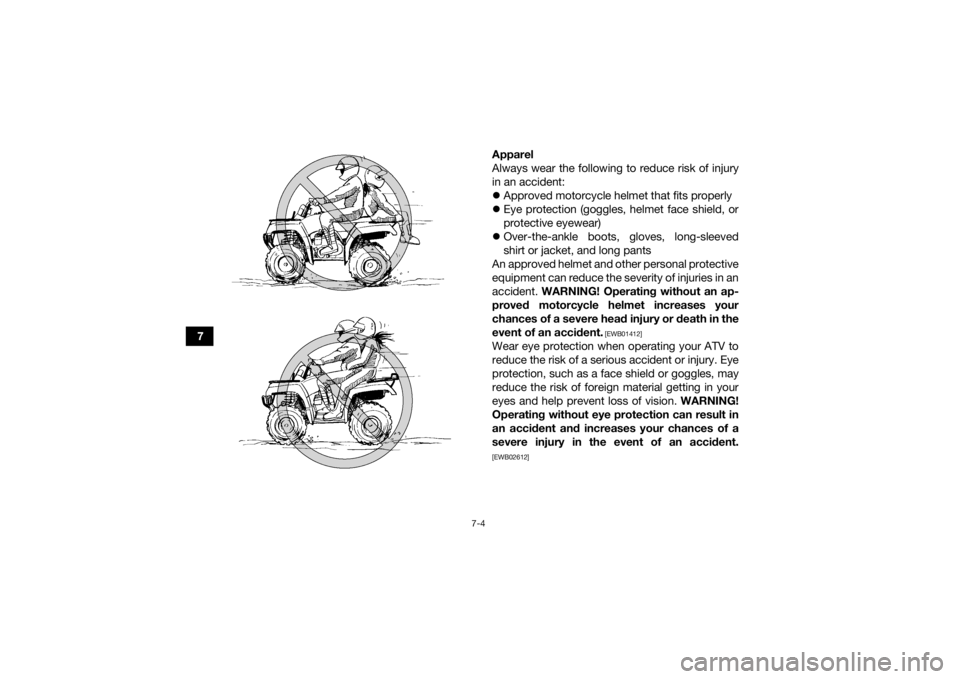
7-4
7Apparel
Always wear the following to reduce risk of injury
in an accident:
Approved motorcycle helmet that fits properly
Eye protection (goggles, helmet face shield, or
protective eyewear)
Over-the-ankle boots, gloves, long-sleeved
shirt or jacket, and long pants
An approved helmet and other personal protective
equipment can reduce the severity of injuries in an
accident. WARNING! Operating without an ap-
proved motorcycle helmet increases your
chances of a severe head injury or death in the
event of an accident.
[EWB01412]
Wear eye protection when operating your ATV to
reduce the risk of a serious accident or injury. Eye
protection, such as a face shield or goggles, may
reduce the risk of foreign material getting in your
eyes and help prevent loss of vision. WARNING!
Operating without eye protection can result in
an accident and increases your chances of a
severe injury in the event of an accident.[EWB02612]
UB1662E0.book Page 4 Monday, April 17, 2017 11:39 AM